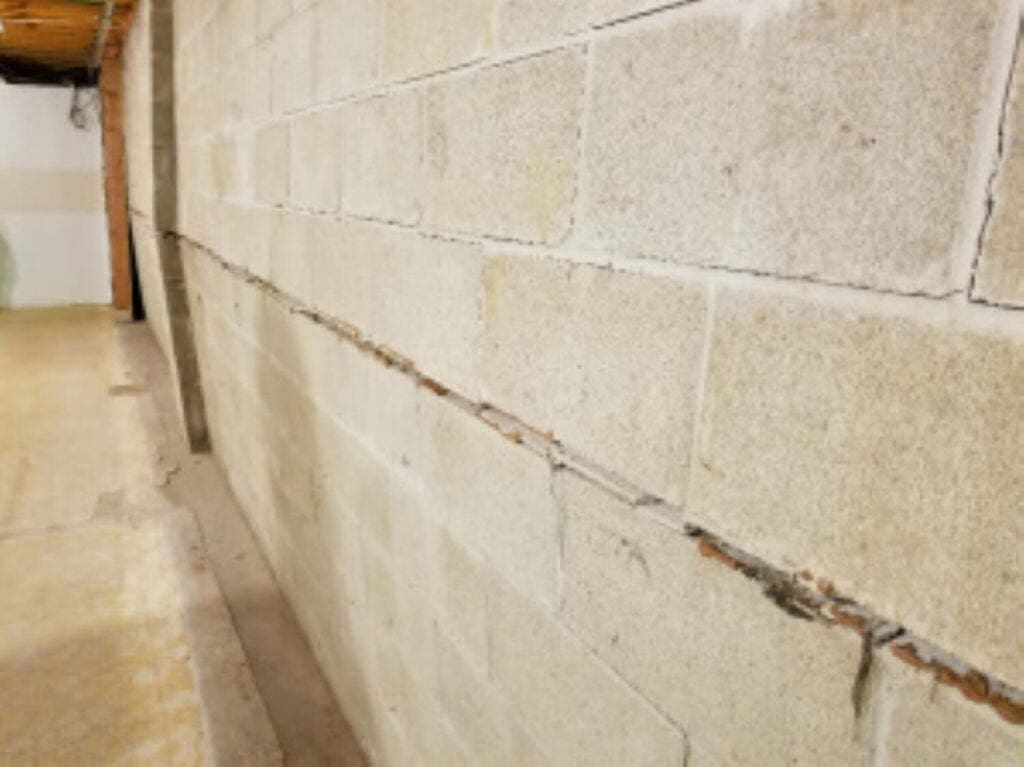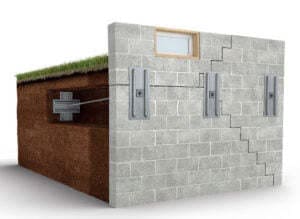
Originally posted 9/24/20, updated 12/15/22
Walls in general are not meant to lean or curve. They should be solid, upright, and holding firm at a 90° angle from the floor. So if you have a wall in your home that doesn’t meet these criteria, you most likely have a problem. And if that problem wall is part of your foundation? You need that assessed, and quickly.
But I bet you already know that, which is what led you here. Wall anchors are an excellent repair method for bowing walls, if properly installed. Acculevel has been repairing foundations and providing basement wall repair since 1996, and we have successfully restored stability to tens of thousands of homes in our service area.
In this article, we’re going to explain what wall anchors are, how they work, when they are the best repair method, and when you might need a different repair method.
 This photo was taken by an Acculevel project advisor during a routine free estimate.
This photo was taken by an Acculevel project advisor during a routine free estimate.
Wall anchors are the best repair option for walls that are bowing more than 2 inches. If your wall is bowing less than that, carbon fiber straps are probably a better option for you. They are less expensive and do not require excavation. Review our article about carbon fiber straps for foundation repair, installation method, and cost of carbon fiber straps.
Wall Anchors are two steel plates, connected by a steel shaft. One of the plates is secured to the inside of your basement wall and the other is buried outside your home in the yard. As the steel shaft is tightened, it applies force to the wall, pulling it back as far as it’s able to go. When the necessary torque is met, the installation is complete. (This torque is the measurement of how much “grip” the anchor has.)
 This is an illustration of a wall anchor installation.
This is an illustration of a wall anchor installation.
As I mentioned, some excavation is necessary to bury the anchor plate in the yard. It needs to be installed at least 10 feet away from the outside of your foundation. This is the tricky part of the equation: is there room outside the bowing wall for that excavation? If your home is located close to your property line on that side- or if there’s something expensive or critical in that area- you may need to consider a different repair option.
Helical tie-backs are an alternative to wall anchors, and don’t require excavation. They are more expensive than wall anchors (more on that later), but it’s often cheaper and easier than relocating a septic tank or garage. We have more information on tie-backs in this blog.
Yes and no. I apologize for the ambiguity- we’re not trying to dodge the question. But this is very dependent on your individual circumstances. The primary purpose of anchors is to stabilize your wall. Acculevel provides a warranty on our installation, and it guarantees that an anchored wall will not bow any more, for as long as your home stands.
Whether or not anchors can be used to straighten a wall- full or partially- will depend on your home and its construction. Our installation crews have repaired thousands of walls with anchors; this experience allows them to assess the wall as the anchors are installed. They will gauge the movement of the wall, and stop when the necessary torque is achieved.
This could mean your wall only bows slightly, or it may still be as bowed as it was when we started.
If you want to restore the wall to 100% plumb (perfectly upright), you should consider having the wall straightened. Wall straightening requires more excavation, this time directly outside your foundation. Once the exterior of the wall is exposed, hydraulic jacks are placed inside the basement to push the wall back into position. After it’s straightened, it’s secured, either by anchors or carbon fiber straps.
Wall anchors cost approximately $830 to $1,000 each, depending on digging method. (This pricing includes materials and labor.) An anchor should be installed approximately every 5 feet along a bowing wall.
Example: If your basement wall is 24 feet long, you will need 4 anchors, which is an estimated $3,320 – 4,000.
Please use our free comprehensive guide to foundation repairs. It can be read in its entirety, you can select the chapter relevant to you, or bookmark it as a reference when you meet with contractors.
If you are ready to have a contractor come to your house and evaluate your basement, please make sure you verify that the company is reputable, insured, and accredited by the Better Business Bureau. Not sure what questions to ask, or what information you should acquire about the company you hire? Please use our guide to questions you should ask a contractor, with a free downloadable form.
If you live in Indiana or the surrounding states, contact Acculevel. We are a family-owned and operated company, and we provide free written estimates. One of our experienced project advisors will evaluate your bowing wall, then recommend the best course of action for you. Our goal is to help you keep your home strong and healthy for years to come.
[DISPLAY_ULTIMATE_SOCIAL_ICONS]